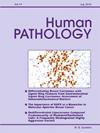Evaluation of 3,606 renal cell tumors for TFE3 rearrangements and TFEB alterations via fluorescence in situ hybridization, next generation sequencing, and GPNMB immunohistochemistry
IF 2.6
2区 医学
Q2 PATHOLOGY
引用次数: 0
Abstract
Molecularly defined renal cell carcinomas include TFE3-rearranged renal cell carcinoma (TFE3-RCC) and TFEB-altered renal cell carcinoma (TFEB-RCC). There is significant morphologic and immunophenotypic overlap between these entities and common renal tumors, such that molecular testing is often required to make the diagnosis. Herein, we reviewed our reference laboratory experience pertaining to TFE3 and TFEB FISH testing, targeted next generation RNA sequencing (NGS), and GPNMB immunohistochemistry (IHC). Most FISH testing (2963/3543, 83.6%) was performed on renal tumors. TFE3 FISH showed rearrangements in 449 of 2467 specimens (18.2%), including 281 (of 1887, 14.9%) renal tumors. TFEB FISH identified an abnormality in 107 of 1076 (9.9%) renal tumors, including 52 (of 107, 48.6%) rearrangements, 41 (of 107, 38.3%) amplifications, or 14 (of 107, 13.1%) with both rearrangements and amplifications. More specifically, TFE3-rearranged, TFEB-rearranged, TFEB-amplified, and TFEB-rearranged/amplified renal tumors occurred in females in 54%, 69.6%, 39.1%, and 40% of cases, respectively. The pediatric and young adult population (aged ≤21 years) included 44 (of 121, 36.3%) TFE3-RCC and 9 (of 50, 18%) TFEB-rearranged RCC. TFE3-RCC fusion partners included RBM10, NONO, ASPSCR1, FUBP1, SFPQ, MAPK1IP1L, and PRCC. TFEB-rearranged RCC fusion partners SYNRG and BYSL were identified. Diffuse GPNMB expression was seen in 92% of TFE3-RCC (24/26; median H-score 275), 100% of TFEB-rearranged RCC (19/19; median H-score 300), and 100% of TFEB-amplified RCC (17/17; 240). Finally, our cohort included 5 eosinophilic TFEB-amplified RCCs with non-focal keratin 20 expression. This large series of TFE3-RCC and TFEB-RCC provides population data regarding these rare tumors and demonstrates the clinical value of targeted FISH strategies. Our results suggest that GPNMB IHC is an effective screen for TFE3-RCC and TFEB-RCC. Additionally, we report a RCC harboring a novel SYNRG::TFEB fusion.
通过荧光原位杂交、下一代测序和GPNMB免疫组织化学评估3606例肾细胞肿瘤TFE3重排和TFEB改变。
分子定义的肾细胞癌包括tfe3重排肾细胞癌(TFE3-RCC)和tfeb改变肾细胞癌(TFEB-RCC)。在这些实体和常见的肾肿瘤之间存在显著的形态学和免疫表型重叠,因此通常需要进行分子检测来进行诊断。在此,我们回顾了我们在TFE3和TFEB FISH检测、靶向下一代RNA测序(NGS)和GPNMB免疫组织化学(IHC)方面的参考实验室经验。大多数FISH检测(2963/3543,83.6%)用于肾脏肿瘤。2467例标本中TFE3 FISH显示重排449例(18.2%),其中肾肿瘤281例(1887例中14.9%)重排。TFEB FISH在1076例肾肿瘤中发现107例(9.9%)异常,其中重排52例(107例中48.6%),扩增41例(107例中38.3%),重排和扩增同时存在的14例(107例中13.1%)。更具体地说,女性肾肿瘤中tfe3重排、tfeb重排、tfeb扩增和tfeb重排/扩增的发生率分别为54%、69.6%、39.1%和40%。儿童和青年人群(年龄≤21岁)包括44例(121例,36.3%)TFE3-RCC和9例(50例,18%)tfe2 - rcc。TFE3-RCC融合伙伴包括RBM10、NONO、ASPSCR1、FUBP1、SFPQ、MAPK1IP1L和PRCC。鉴定了tfeb重排RCC融合伙伴SYNRG和BYSL。在92%的TFE3-RCC中可见弥漫性GPNMB表达(24/26;中位h评分275),tfeb重排RCC 100% (19/19;中位h评分300),tfeb扩增的RCC为100% (17/17;240)。最后,我们的队列包括5例非局灶性角蛋白20表达的嗜酸性tfeb扩增rcc。这一系列的TFE3-RCC和TFEB-RCC提供了关于这些罕见肿瘤的人群数据,并证明了靶向FISH策略的临床价值。我们的结果表明GPNMB IHC是TFE3-RCC和tfe2 - rcc的有效筛选。此外,我们还报道了一例含有新型SYNRG::TFEB融合的RCC。
本文章由计算机程序翻译,如有差异,请以英文原文为准。
求助全文
约1分钟内获得全文
求助全文
来源期刊

Human pathology
医学-病理学
CiteScore
5.30
自引率
6.10%
发文量
206
审稿时长
21 days
期刊介绍:
Human Pathology is designed to bring information of clinicopathologic significance to human disease to the laboratory and clinical physician. It presents information drawn from morphologic and clinical laboratory studies with direct relevance to the understanding of human diseases. Papers published concern morphologic and clinicopathologic observations, reviews of diseases, analyses of problems in pathology, significant collections of case material and advances in concepts or techniques of value in the analysis and diagnosis of disease. Theoretical and experimental pathology and molecular biology pertinent to human disease are included. This critical journal is well illustrated with exceptional reproductions of photomicrographs and microscopic anatomy.
 求助内容:
求助内容: 应助结果提醒方式:
应助结果提醒方式:


